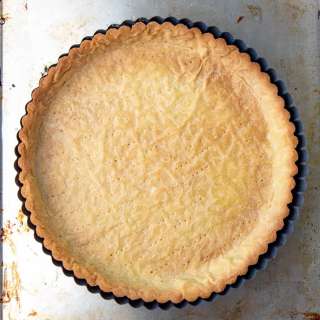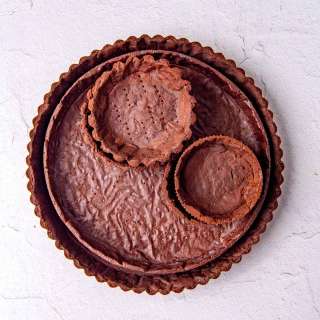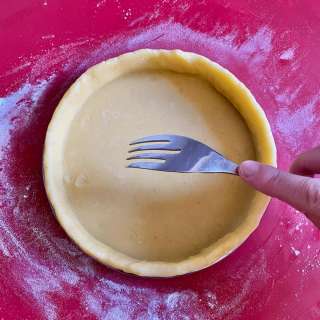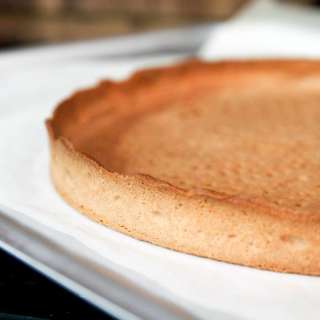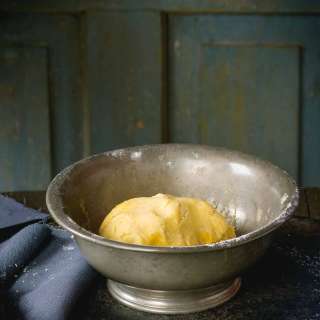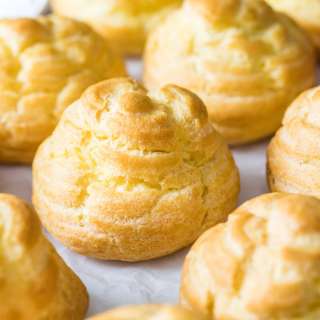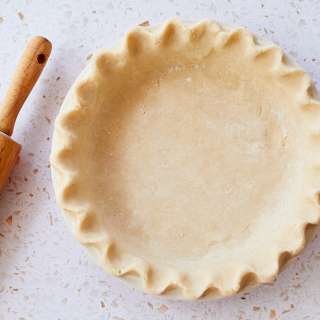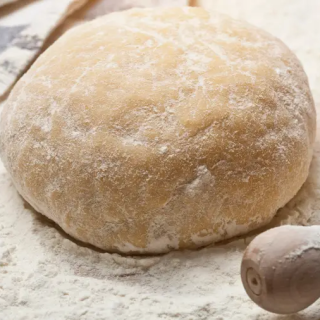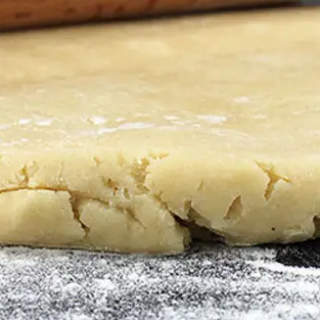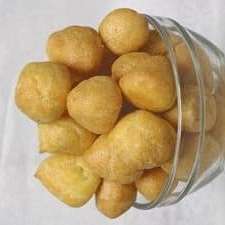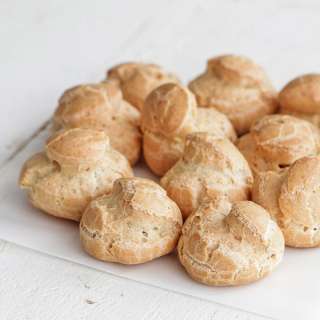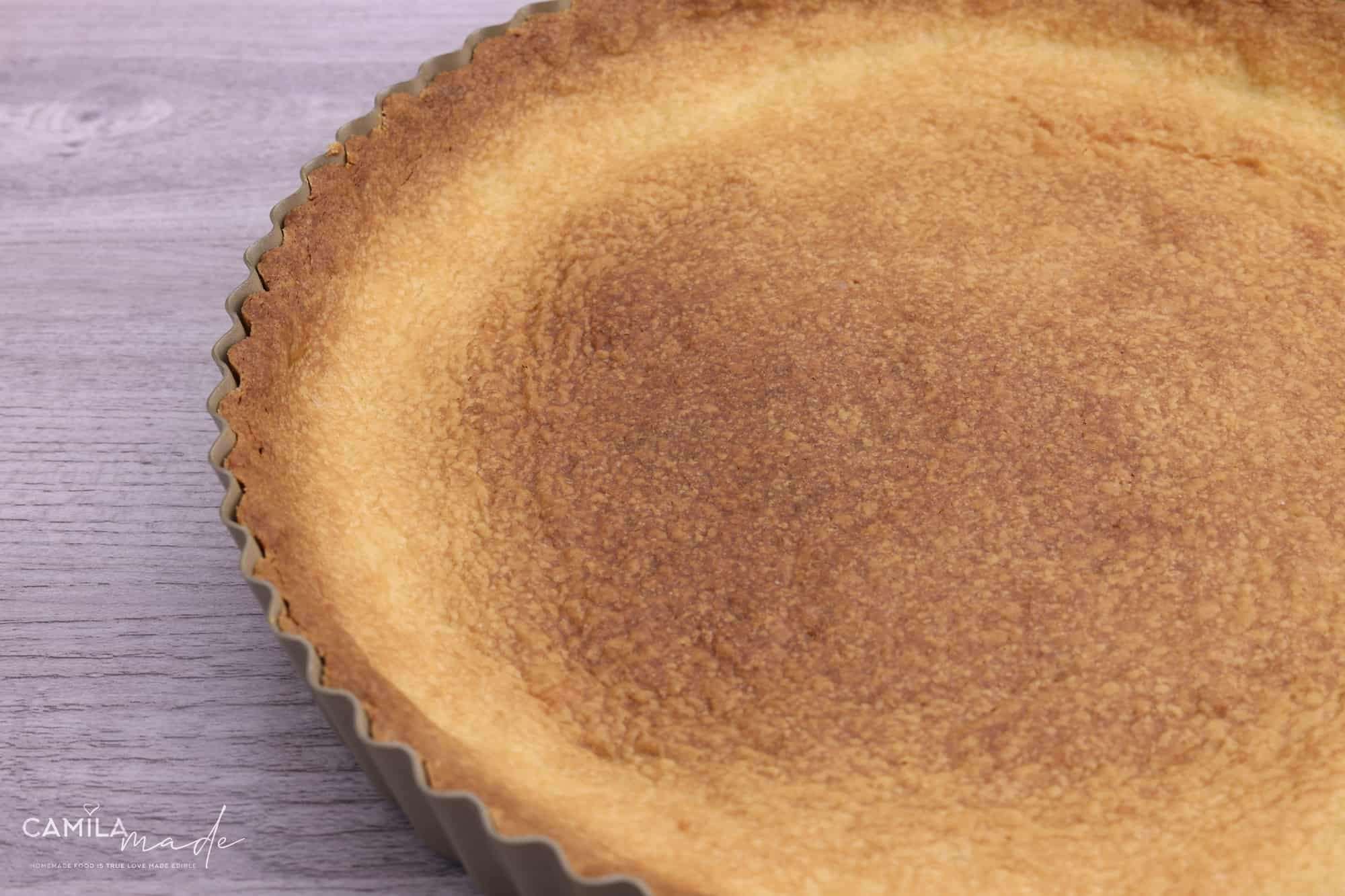
Easy Pate Sucree
User Reviews
5.0

Easy Pate Sucree
Pate sucree is a sweet version of shortcrust pastry. It is originally French, as its name might suggest. It is a dough that does not need leavening agents. It has a delicate, tender, buttery, and highly friable texture (it crumbles very easily), giving it a distinct quality described as "sandy," and precisely what sablée means. It is the ideal type of dough for making tarts filled with lemon curd, pastry cream, or chocolate. This Pate Sucree recipe can be made in two ways: pressing directly into the tart mold or rolling it out on a lightly floured surface with a rolling pin until it is large enough to fit a 10x 1-inch high fluted tart with a removable bottom. I find it simpler to press the dough into the bottom and sides of the mold. Feel free to double the recipe and store one in the freezer for later use.
Ingredients
- 113 g (1 stick / ½ cup ) unsalted butter, at room temperature
- ⅓ cup powdered sugar or granulated sugar
- 1¼ cup all-purpose flour spooned into measuring cup and leveled-off
- 1 large egg yolk , lightly beaten
- 1 teaspoon pure vanilla extract
- ¼ teaspoon kosher salt
- 2 teaspoons ice-cold water or as needed
Instructions
- Lightly beat the yolk, one teaspoon vanilla, and two teaspoons cold water in a small bowl until combined; keep in the refrigerator until needed.
- In the bowl of a food processor, add flour, powdered sugar, and kosher salt and pulse a few times to combine about four times.
- Next, add butter and quick pulse times until it resembles coarse crumbs, about 1o to 15 seconds; you don't want them smaller than that as the butter will further be broken up in the next step.
- Next, with the machine running, add the yolk mixture in a slow, steady stream. Process just until the dough holds together, about 8 to 15 pulses; the dough should not come together entirely into a ball. Instead, it should look loose but holds together when pinched.
- Alternatively, you can make it in a stand mixer fitted with a paddle attachment, cream the butter, sugar, salt, and vanilla for 2 to 3 minutes, or until pale and creamy; scrape down the sides and bottom of the bowl, and the paddle with a rubber spatula. Add the flour and mix on low speed for about 30 seconds or until the flour is fully incorporated; the mixture will look like wet sand.
- Add the egg yolk and mix until the dough comes together; do not mix for more than 30 seconds. Or mix by hand; combine dry ingredients in a large mixing bowl; using a pastry blender or fork, cut in butter until mixture resembles a coarse meal.
- Remove the dough from the bowl, and press it into a disk. If you're rolling it, wrap it tightly in a double layer of plastic wrap, and let it rest in the refrigerator for about 1 hour or overnight. Otherwise, if it's not too hot, immediately press it into a 10x 1-inch high fluted tart with a removable bottom (it is easier to handle). But if too hot, then press it into a disk, wrap it tightly in a double layer of plastic wrap, and let it rest in the refrigerator for a least 30 minutes to relax the dough.
- Use your fingers and the heel of your hand or a flat-bottomed measuring cup to press the dough firmly and evenly into an even layer on the bottom and up the sides, making sure not to let the crust thicken at the corners of a 10-inch tart pan with a removable bottom. (It may seem like you won't have enough dough, but it will come together; be patient)
- Trim off any excess with a paring knife, so the dough is perfectly even with the rim of the pan. If there are any bare spots, patch them up using the trimmed-off dough. ( If the pastry dough softens too quickly, refrigerate for 2 to 5 minutes). Finally, dock the bottom of the crust with a fork to keep bubbles from forming during baking. Cover with a plastic wrap and refrigerate them for 1-½ hours to let the dough rest.
- For Rolling Method: Remove dough from the refrigerator and let it thaw slightly to make it malleable if stiff for about 5 to 10 minutes. Dust a clean work surface and a rolling pin with flour. Roll the pastry dough into a flat circle by applying even pressure and rotating the dough between passes.
- Use a bench scraper to lift the dough and gently lay it inside a 10x 1-inch high fluted tart with a removable bottom. Trim off any excess with a paring knife, so the dough is perfectly even with the rim of the pan. If there are any bare spots, patch them up using the trimmed-off dough. Dock the bottom of the crust with a fork.
- Preheat the oven to 350 degrees F and place a rack in the center of the oven. Place the pate sucree on a baking sheet and bake for 25 to 30 minutes or until golden brown. Remove from the oven and let cool completely on a wire rack. Gently remove the tart ring and transfer the shell to a serving platter. Fill as desired.
Notes
- How to Store & Re-Heat
- How to Store & Re-Heat
- To store: Place the baked and cooled tart shell in an airtight container or wrap it tightly in plastic. Store it in the refrigerator to maintain its freshness. The tart shell can typically be stored for 2 to 3 days. If the tart has been filled, store it in the refrigerator, covering it with plastic wrap or placing it in a cake carrier to prevent drying. Filled tarts are best consumed within 1 to 2 days.
- To store: Place the baked and cooled tart shell in an airtight container or wrap it tightly in plastic. Store it in the refrigerator to maintain its freshness. The tart shell can typically be stored for 2 to 3 days. If the tart has been filled, store it in the refrigerator, covering it with plastic wrap or placing it in a cake carrier to prevent drying. Filled tarts are best consumed within 1 to 2 days.
- To reheat: Preheat the oven to a low temperature, around 300°F (150°C). Place the tart on a baking sheet and warm it in the oven for 10 to 15 minutes until it reaches the desired temperature. Be careful not to overheat, as it may affect the texture of the tart shell or cause the fillings to become runny. Alternatively, you can enjoy the tart at room temperature without reheating, as the delicate texture of Pate Sucree is enjoyable both cold and at room temperature. Consider the specific storage and reheating instructions for the filling used in your tart.
- To reheat: Preheat the oven to a low temperature, around 300°F (150°C). Place the tart on a baking sheet and warm it in the oven for 10 to 15 minutes until it reaches the desired temperature. Be careful not to overheat, as it may affect the texture of the tart shell or cause the fillings to become runny. Alternatively, you can enjoy the tart at room temperature without reheating, as the delicate texture of Pate Sucree is enjoyable both cold and at room temperature. Consider the specific storage and reheating instructions for the filling used in your tart.
- Make-Ahead
- Make-Ahead
- Pate Sucree can be made beforehand to save preparation time when needed. After preparing the dough, wrap it tightly in plastic wrap and refrigerate it for up to 2 days. If you plan to store it longer, you can freeze the dough for up to 2 months. When ready to use, allow the dough to thaw in the refrigerator overnight if frozen. Once thawed or chilled, press the dough into the tart mold or roll it out as desired. Making the Pate Sucree ahead of time allows for convenient preparation and ensures you have a ready-to-use tart shell when needed.
- Pate Sucree can be made beforehand to save preparation time when needed. After preparing the dough, wrap it tightly in plastic wrap and refrigerate it for up to 2 days. If you plan to store it longer, you can freeze the dough for up to 2 months. When ready to use, allow the dough to thaw in the refrigerator overnight if frozen. Once thawed or chilled, press the dough into the tart mold or roll it out as desired. Making the Pate Sucree ahead of time allows for convenient preparation and ensures you have a ready-to-use tart shell when needed.
- How to Freeze
- How to Freeze
- To freeze Pate Sucree, follow these steps. First, shape the dough into a disk or wrap it tightly in plastic wrap. Place the wrapped dough in a freezer-safe bag or airtight container to protect it from freezer burn. Label the container with the date for easy reference. When you're ready to use the dough, transfer it to the refrigerator and let it thaw overnight. Once thawed, press it into the tart mold or roll it out as desired. Freezing Pate Sucree is a convenient way to have dough for future use, allowing you to prepare tarts quickly and easily.
- To freeze Pate Sucree, follow these steps. First, shape the dough into a disk or wrap it tightly in plastic wrap. Place the wrapped dough in a freezer-safe bag or airtight container to protect it from freezer burn. Label the container with the date for easy reference. When you're ready to use the dough, transfer it to the refrigerator and let it thaw overnight. Once thawed, press it into the tart mold or roll it out as desired. Freezing Pate Sucree is a convenient way to have dough for future use, allowing you to prepare tarts quickly and easily.
- Notes:
- The Pate Sucree dough can be tightly wrapped in a double-layer plastic wrap and stored in the refrigerator for up to 5 days.
- Baked Pate Sucree can be stored, well wrapped, at room temperature for up to 1 week.
- The Pate Sucree dough can be tightly wrapped in a double-layer plastic wrap and stored in the refrigerator for up to 5 days.
- Baked Pate Sucree can be stored, well wrapped, at room temperature for up to 1 week.
